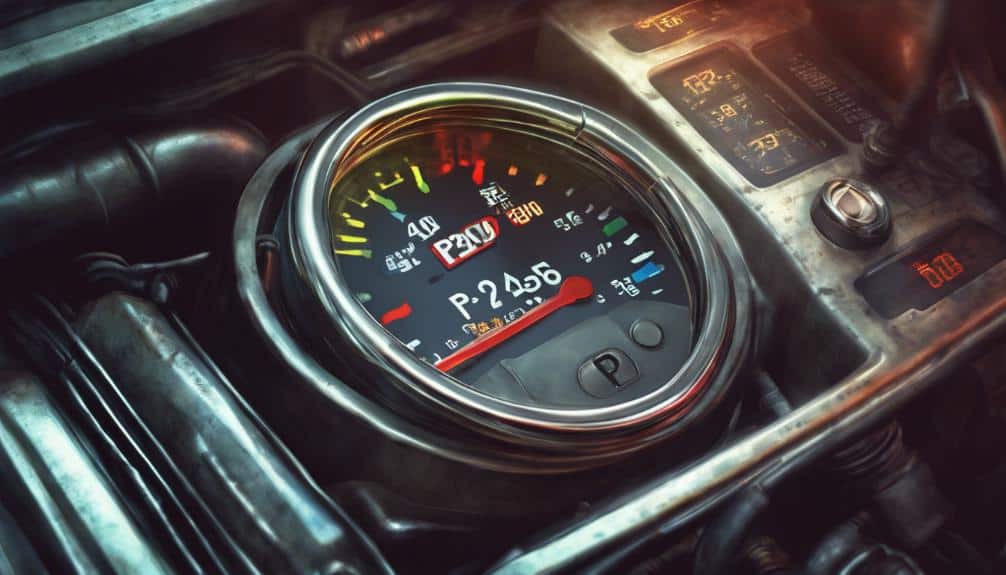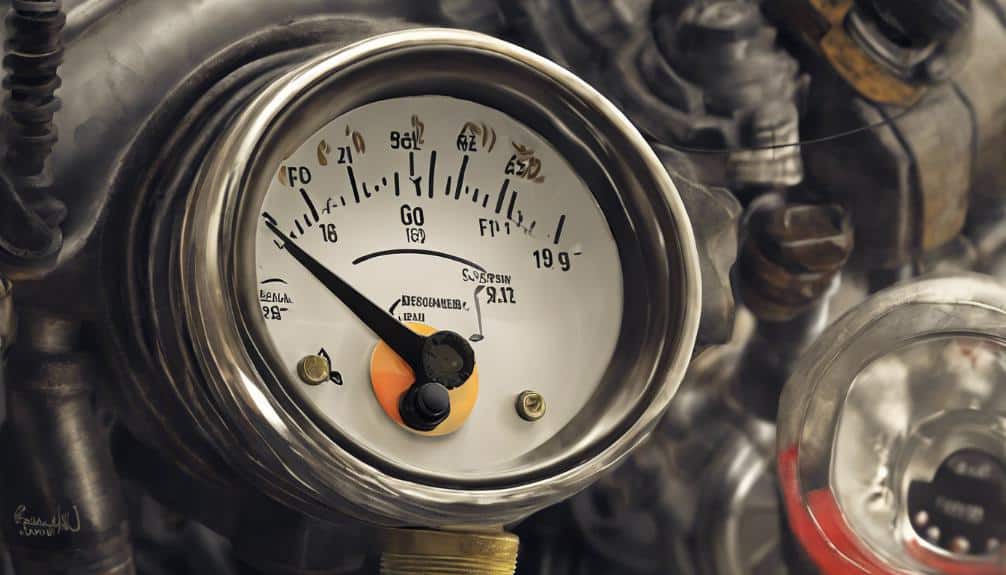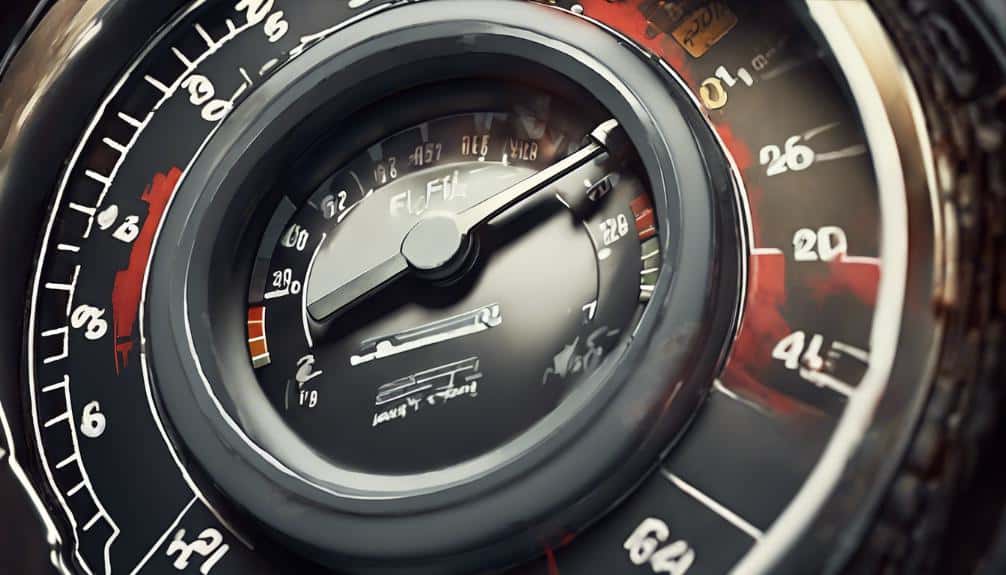When your fuel pressure climbs too high, causing the P228D code, act promptly to prevent engine harm and maintain efficiency.
Symptoms of excessive fuel pressure include engine misfires, rough idling, reduced fuel economy, and black exhaust smoke.
Causes can range from fuel system issues to sensor malfunctions, necessitating quick diagnosis and resolution. Check engine oil pressure, examine the fuel pressure sensor, assess wiring, and evaluate PCM for errors.
Proper fuel pressure maintenance ensures smooth engine function, preventing misfires and stalling while optimizing fuel usage and engine lifespan. Addressing P228D promptly is key to vehicle health and performance optimization.
Key Points
- P228D code indicates high fuel pressure from Fuel Pressure Regulator 1.
- Symptoms include misfires, rough idling, decreased fuel efficiency, and black smoke.
- Causes may stem from fuel system issues or regulator malfunctions.
- Diagnosis involves checking oil pressure, sensor, wiring, and PCM errors.
- Proper fuel pressure maintenance is crucial for engine efficiency and longevity.
Understanding OBD-II Fault Code P228D

If you’re troubleshooting a P228D code in your vehicle, understanding the OBD-II Fault Code P228D is essential.
This code indicates that Fuel Pressure Regulator 1 has exceeded control limits, resulting in pressure that’s too high. When dealing with this issue, fuel pressure troubleshooting is vital.
You need to assess the regulator performance to identify the root cause of the problem accurately.
To address the P228D code, begin by checking the fuel pressure regulator’s performance. This involves examining the regulator’s ability to maintain the correct pressure levels within the system.
Be sure that the regulator is functioning correctly and not allowing the pressure to spike excessively. If the regulator isn’t performing as expected, it could lead to high fuel pressure issues triggering the P228D code.
Symptoms of High Fuel Pressure
Experiencing symptoms of high fuel pressure can indicate underlying issues affecting your vehicle’s performance and efficiency. High fuel pressure can lead to various problems that impact engine performance and fuel efficiency.
Symptoms may include engine misfires, rough idling, decreased fuel efficiency, and black smoke coming from the exhaust.
Also, excessive fuel pressure can result in a no-start condition and trigger the check engine light. If left unaddressed, problems with fuel pressure could lead to engine stalling and issues with idle control.
On top of that, high fuel pressure may cause decreased engine performance and limit your vehicle’s speed. It’s important to address high fuel pressure promptly to prevent potential engine damage and safety hazards.
Keeping an eye out for these symptoms and taking action can help maintain your vehicle’s overall performance and efficiency levels.
Causes of Fuel Pressure Regulator 1 Exceeding Limits

When fuel pressure regulator 1 exceeds its limits, various issues impacting your vehicle’s performance may arise.
- Fuel system: Excessive pressure can lead to fuel leaks, affecting the overall efficiency of the system.
- Regulator troubleshooting: Incorrect fuel pressure regulation may result in engine misfires or rough idling, indicating a need for regulator inspection.
- Sensor malfunctions: Faulty sensors can send incorrect signals to the fuel pressure regulator, causing pressure spikes beyond recommended levels.
- Wiring problems: Damaged wiring connections can disrupt the communication between the regulator and the engine control unit, leading to irregular fuel pressure readings.
Addressing these causes promptly through proper diagnosis and repair procedures is essential to maintain the health of your vehicle’s fuel system and ensure peak performance.
If you suspect issues with your fuel pressure regulator, seeking professional assistance for thorough troubleshooting is advisable to prevent further complications.
Diagnosing and Resolving P228D Code
To address the P228D code indicating high fuel pressure, focus on diagnosing and resolving the issue promptly to prevent further engine complications and maintain peak performance.
When troubleshooting the P228D code, common solutions involve checking the engine oil pressure, inspecting for sensor faults, examining wiring issues, and evaluating PCM errors.
Begin by ensuring the engine oil pressure is within the manufacturer’s specifications.
Next, inspect the fuel pressure sensor for any signs of damage or malfunction. Verify the wiring connections are secure and free from corrosion.
Also, conduct a thorough check of the PCM for any potential errors that could be causing the high fuel pressure readings.
If these steps don’t resolve the issue, consider replacing the fuel pressure sensor, adjusting the engine control module settings, or repairing any faulty regulator circuits.
Prompt action is essential to prevent engine damage, misfires, decreased fuel efficiency, and potential breakdowns.
Can Adding Dry Gas Cause Your Fuel Pressure to Become Too High?
Adding dry gas for fuel tank is unlikely to cause fuel pressure to become too high. Dry gas is primarily used to remove water from the fuel system, which can lead to issues such as corrosion and fuel line freeze-ups. It is more likely that other factors are causing high fuel pressure.
Importance of Maintaining Proper Fuel Pressure

Why is maintaining proper fuel pressure essential for your vehicle’s performance and longevity? Proper fuel pressure plays a vital role in ensuring that your engine operates efficiently and effectively.
Here are some benefits of maintaining the correct fuel pressure:
- Efficient engine performance: Proper fuel pressure ensures that your engine receives the right amount of fuel for combustion, leading to peak performance.
- Prevention of engine misfires and stalling: Maintaining the correct fuel pressure helps prevent common issues like engine misfires and stalling, which can disrupt your driving experience.
- Fuel efficiency: Incorrect fuel pressure can lead to reduced fuel efficiency, costing you more at the pump over time.
- Engine longevity: By monitoring and adjusting fuel pressure as needed, you can help prevent potential engine damage that may arise from high or low fuel pressure scenarios.
Being mindful of common fuel pressure issues and the benefits of proper fuel pressure can help you keep your vehicle running smoothly and efficiently.
Preventing Engine Damage With P228D Code
Preventing engine damage associated with the P228D code involves monitoring fuel pressure levels consistently.
Proper fuel pressure regulation is essential for maintaining engine performance and preventing potential issues. When faced with the P228D code, it’s important to address it promptly to avoid further damage.
Excessive fuel pressure can lead to engine misfires, reduced fuel efficiency, and black smoke emissions from the exhaust, indicating underlying problems that could worsen over time.
To safeguard your engine from damage linked to the P228D code, consider regular maintenance practices and adhere to the manufacturer’s maintenance schedule.
Using quality fuel and ensuring the fuel system is clean can also help prevent issues related to high fuel pressure.
By staying proactive and addressing any warning signs promptly, such as unusual engine behavior or decreased performance, you can mitigate the risk of severe damage and costly repairs.
Remember, maintaining good fuel pressure is key to preserving your engine’s health and longevity.
As an Amazon Associate we earn from qualifying purchases.










